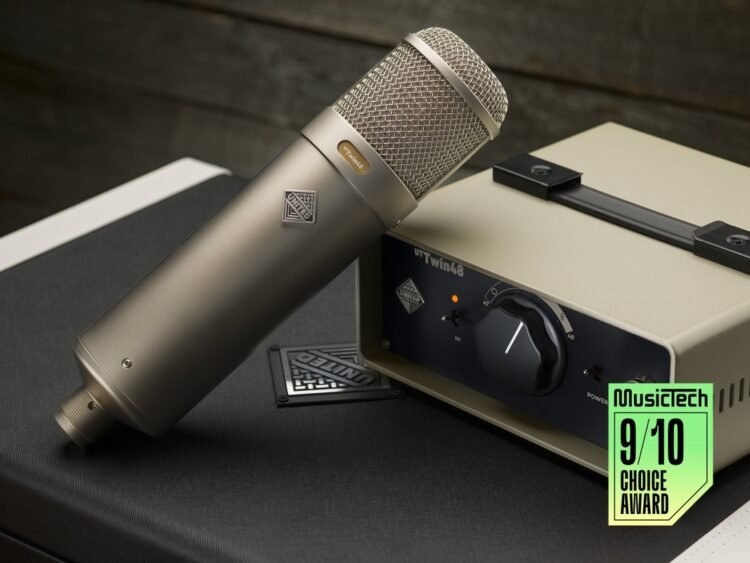£1,499, unitedstudiotech.com
The original Neumann U 47 is arguably the most legendary of all studio condenser microphones. It’s undoubtedly the best-known valve mic. Not nearly as famous, though, is the U 48. In fact, today’s producers and engineers who know of the U 48 are probably well represented by Beatles recording historians. That’s because the vast majority of Beatles lead vocals were recorded with a Neumann U 48.
United Studio Technologies’ UT Twin48 not only aims to offer the sound and capability of the U 48s used to record those classic Beatles tracks, but also the familiar features and character of the much-loved U 47.
The main difference between 47 and 48 style microphones is their polar response options. While both types offer cardioid patterns, the 47 features an omni response while the 48 includes a figure-8 pattern. However, the type of cardioid response of each is implemented in its own unique way, resulting in the Twin48’s two cardioid modes sounding distinctly different. The technology employed for 47 cardioid is known as ‘true cardioid’, while 48 cardioid is ‘active cardioid’ as it polarises the rear diaphragm with voltage, rather than decoupling it. This makes the mic’s 48 cardioid mode slightly less sensitive, meaning you’ll need to turn up your preamp a notch or two to match the level of 47 cardioid.
Auditioning these modes, as well as omni and figure-8, is made simple with a rotary switch on the front of the Twin48’s large external power supply. This supply is fully discrete, incorporating a multitude of bespoke parts and includes a radio frequency (RF) filter, selectable on the supply’s front panel. The Twin48 connects to its power supply via a Sommer Octave 7 conductor cable, which UT claims is the finest tube microphone cable currently available.

At the business end of the Twin48 is UT’s custom K48 capsule. The single backplate, dual diaphragm design is historically correct, according to the manufacturer, being skinned within a ‘laboratory clean-room environment’, then sputtered with 24-carat gold on 6-micron Mylar. UT’s claim that the K48 matches the smooth, resonance-free performance of historical units proves correct in use; there’s nothing sharp, spiky or sibilant about its performance.
The Twin48’s UT-BV8 transformer is made in the US, custom wound to Braunbuch specifications. Apparently, measurements were taken from a ‘golden specimen’ of the historic German transformer, no less. A copper Faraday shield is also onboard to reduce radio frequency interference (RFI), while the thermionic valve element is provided by a NOS EF86 vacuum tube.
Here then, we have two world-class valve microphones in one package. The thing about high-quality microphones is that, heard in isolation, they all sound great or even ‘correct’. And surely that’s the aim; to be neutral, truthful and transparent to the source. The truth is however, that all mics possess character that often only becomes apparent when heard in comparison with others. The Twin48 makes this evaluation easy.

Although the manufacturer states that the different approaches to cardioid operation produces ‘subtle tone differences’, a phrase that often translates into ‘you won ’t hear the difference unless you have golden ears’, this isn’t the case with the sounds available from the Twin48. Even to an untrained ear, the sonic character of each cardioid mode is instantly noticeable. While the 47 mode possesses the big, expansive, open and airy quality engineers have loved for decades, the 48 mode offers a more tightly focused midrange sound, reminiscent of my beloved Neumann U 67, which I find more suited to recording pop vocals that will be subject to subsequent audio processing.
In practice, I would choose the Twin48’s 47 cardioid mode to capture a vocalist performing in a natural style, such as a singer/songwriter with acoustic backing, where the lead vocal is prominent and largely in its own space. For rock and pop vocals that need to project from a busy backing track, I prefer the 48 cardioid mode with a presence boost and maybe a little added air from a Pultec-style EQ boosting at 16k Hz.
Having two distinctive characteristics – four if you take into account the sonic variation of omni and bi-directional settings – available at the flick of a switch is useful in so many ways. Double-tracked vocals, for example, can benefit from the tonal variation. Or you might choose, say the 47 in cardioid mode for a lead vocal, then have a couple of backing vocalists working on either side of the Twin48 in figure-8 configuration.
The way that the mic’s timbral variations can be utilised instantaneously by turning the dial on the power unit, makes finding the right tone simple and intuitive. This versatility means that the Twin48 can be used to record practically anything and sound superb. Its only real limitation is its size, so it probably wouldn’t be the first choice for close mic’ing a snare in the context of a cluttered drum kit. As an overhead though, it can capture the tonal range and impact of the entire kit, rather than just being considered a cymbal microphone.

Recording acoustic guitar with the Twin48 produces superb results. Some engineers choose to use two small-diaphragm condenser mics for this task, however I nearly always prefer to use a single, well-placed microphone. In the studio, I find the 47 omni setting engaged results in a lush, entirely natural sound, with no proximity effect, requiring just a spot of compression to produce the final sound.
It’s been a long time since I used anything other than a vintage valve Neumann U 67 to record our upright piano, however in a side-by-side comparison with the Twin48 in 48 cardioid mode, I ultimately prefer the slightly less dark, mid-focused tone of UT’s new mic. A stunning outcome!
United Studio Technologies’ Twin48 offers a wide range of top-drawer sounds for a very reasonable price considering the quality of the complete package, which includes an attractive, sturdy carrying case.
Anyone wishing to purchase a 47-style microphone should audition this winner from UT. Not only do you get the classic U 47 sound and performance, but also the Fab-Four-friendly character of the lesser-known U 48.
Compared with other Neumann-inspired large diaphragm condenser mics, the Twin48 is twice as nice.
Key features
- Large diaphragm valve condenser mic
- U 47- and U48-inspired cardioid patterns
- Omni and figure-of-8 polar patterns
- NOS EF86 pentode vacuum tube
- Nickel electroplated brass body
- Bespoke 7 conductor XLR cable
- Suspension shock mount
- Gold plated XLR
- Frequency response: 20 Hz – 20 kHz
- Self noise: 11 dBA

John has been reviewing hardware for MusicTech since 2011. He’s passionate about classic analogue gear, especially anything with tubes glowing inside. Starting out as a Tape-Op in 1985, he loves combining old-school techniques with modern recording practice, working alongside established artists such as Portishead as well as contemporary artists and producers.
Get the MusicTech newsletter
Get the latest news, reviews and tutorials to your inbox.






